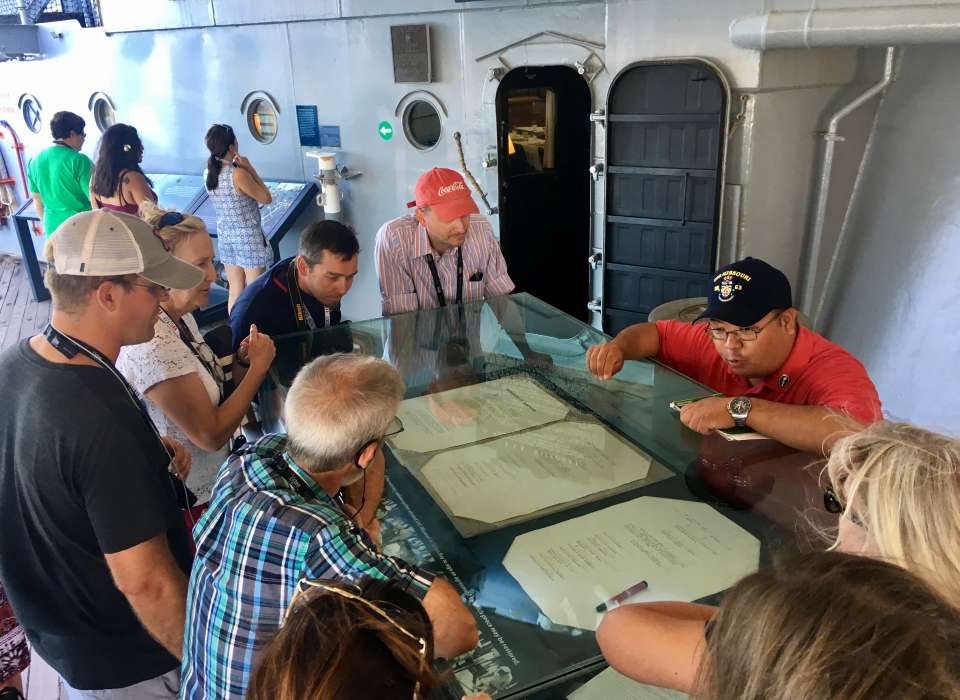Members of the inaugural class of the Museum’s WWII Summer Teacher Institute—Team Pacific—have been in Hawaii this week to complete their year of participation in the program. These 30 middle school and high school teachers from around the country came to the Museum in summer 2016 to study World War II in the Pacific with historian and author Richard B. Frank. Each was provided a Museum-created curriculum guide in exchange for a commitment to share its content and the lessons they’d learned with teachers in their hometown. So far, those lessons have been shared with more than 1,000 teachers. The Institute’s second class—Team Europe—will assemble in New Orleans next week to study World War II in Europe with Donald L. Miller, PhD, then reconvene next summer for a week of study in Normandy, France.
Members of Team Pacific are sending daily dispatches about their experiences in Hawaii. Here’s a Day Four report from Diane Gerard, a high school teacher from Mobile, Alabama:
In many ways, today's activities at Pearl Harbor brought to fruition a sense of place that only students of history (and all of us continue to be such) can genuinely appreciate. Our guides this week have asked us to reimagine the lush pastures and densely wooded areas of a working cattle ranch as it existed 75 years earlier -- a place quickly transformed into a vital communications and defense center for the island of Oahu, complete with an airstrip, bunkers, and barracks for the men who would be trained to fight a war none likely expected. They have led us across an abandoned airfield to see the places where the metal of planes hit by Japanese Zeros on December 7, 1941, literally melted into the pavement -- and asked us again to imagine the pilots of those Japanese planes, circling low in their approach between the mountains before us, young men confident knowing that they had the element of complete surprise.
I have told the story of this day many times before, but standing on the very ground where the events of that December day took place makes a difference. It connects us to the past in a way that even the best lectures, photographs, and textbooks cannot. Today at Pearl Harbor we looked down on the USS Arizona, our thoughts on the ship and many of its crew at rest below. We read the names of those who were lucky enough to survive that day but after living out their respective lives chose the watery grave of their brothers-in-arms as their final resting place. We listened to Rich Frank talk about the attack on the USS Oklahoma – and I’m sure all of us, as we recalled the more than 400 men who lost their lives that day, found some solace in the fact that many will, in some sense, complete their life's journey thanks to the dedicated men and women working here for the Defense POW/MIA Accounting Agency (DPAA) to identify them and return them to their families. We visited the Pacific Aviation Museum, and our guide passionately brought to life the planes on display. Finally, our day ended with a tour of the USS Missouri, the site of the Japanese surrender.
Our guide on the Missouri today, Neil Yamamoto, grandson of a WWII veteran, understands the sense of place that the battleship offers, as did all of the guides this week. This is the value of the experience we have shared at Pearl Harbor. Being here -- walking on what is sacred ground in the history of a people and a place, talking to those who want to share this with others -- has affected all of us in the most subtle of ways, and we too will seek to do the same with our students in the years to come.
Visit ww2classroom.org to see WWII Summer Teacher Institute curriculum guide content.
Special thanks to the David I. Oreck Foundation and the Patrick F. Taylor Foundation for their generous support of this program.
